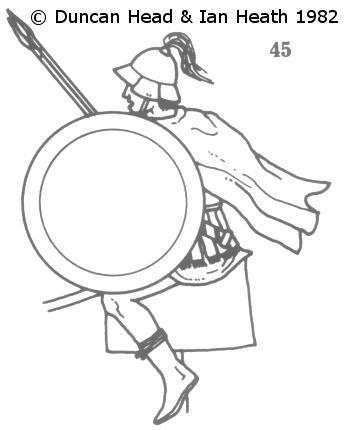
|
HELLENISTIC GREEK SHIELDED HEAVY CAVALRYMAN
An extract from Armies of the Macedonian and Punic Warsby Duncan Head, illustrated by Ian Heath
45. HELLENISTIC GREEK SHIELDED HEAVY CAVALRYMAN

|
This figure is basically similar to 25 with a hoplite-type shield added, based on two reliefs from Thespiai in Boiotia. Greek cavalry adopted shields probably in the 3rd century, either after the appearance of Tarantine mercenaries in 317, or after Pyrrhos’ Italian campaign of 281-75, when he met shielded Tarantine and Roman cavalry and may have brought shields back for his cavalry, and the contemporary incursion of shielded Galatian cavalry into Greece. The appearance of Thracian cavalry without shields in the early 3rd century Kazanluk paintings (figure 68) inclines me to favour the later date rather than postulating a rapid introduction after 317. Most Greek cavalry seem to have retained their traditional javelins rather than being re-armed, as the infantry were, after the Macedonian style. For possible exceptions see under figure 47. The much praised Aitolian cavalry are said by Livy to have used spears, not unfortunately further defined, and some at least wore cuirasses. In view of their general poverty and rapid mobile tactics these may perhaps have been non-metallic, but some may well have bought or looted metal armour.